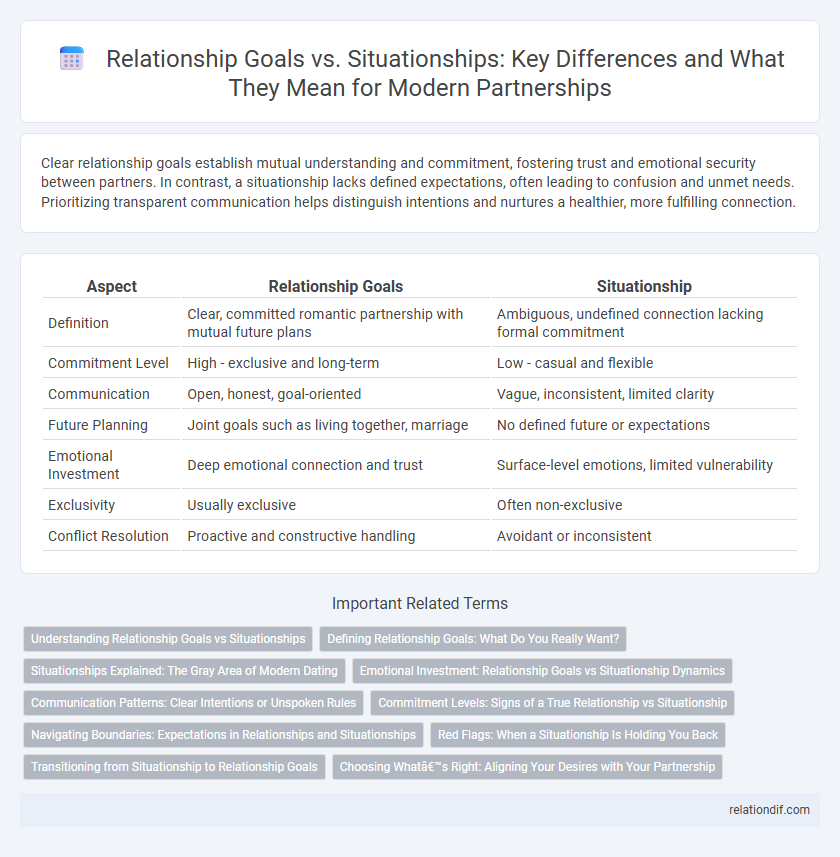Clear relationship goals establish mutual understanding and commitment, fostering trust and emotional security between partners. In contrast, a situationship lacks defined expectations, often leading to confusion and unmet needs. Prioritizing transparent communication helps distinguish intentions and nurtures a healthier, more fulfilling connection.
Table of Comparison
| Aspect | Relationship Goals | Situationship |
|---|---|---|
| Definition | Clear, committed romantic partnership with mutual future plans | Ambiguous, undefined connection lacking formal commitment |
| Commitment Level | High - exclusive and long-term | Low - casual and flexible |
| Communication | Open, honest, goal-oriented | Vague, inconsistent, limited clarity |
| Future Planning | Joint goals such as living together, marriage | No defined future or expectations |
| Emotional Investment | Deep emotional connection and trust | Surface-level emotions, limited vulnerability |
| Exclusivity | Usually exclusive | Often non-exclusive |
| Conflict Resolution | Proactive and constructive handling | Avoidant or inconsistent |
Understanding Relationship Goals vs Situationships
Understanding relationship goals versus situationships involves recognizing clear intentions and boundaries in a committed partnership compared to the ambiguous nature of situationships. Relationship goals prioritize mutual growth, communication, and long-term compatibility, while situationships often lack defined commitment and emotional clarity. Identifying these differences helps individuals navigate expectations and foster healthier connections.
Defining Relationship Goals: What Do You Really Want?
Defining relationship goals requires clear communication about mutual values, long-term intentions, and emotional needs to avoid the ambiguity of a situationship. Establishing specific goals such as commitment level, future plans, and boundaries fosters trust and alignment between partners. Prioritizing transparency and self-awareness helps partners create a meaningful connection that transcends temporary or undefined arrangements.
Situationships Explained: The Gray Area of Modern Dating
Situationships represent a nebulous zone between casual dating and committed relationships, characterized by emotional ambiguity and undefined boundaries. Unlike clear relationship goals that establish mutual expectations and future plans, situationships thrive on uncertainty and lack formal labels, often leading to confusion and unequal emotional investment. Understanding the dynamics of situationships helps individuals navigate the complexities of modern dating, promoting clearer communication and self-awareness.
Emotional Investment: Relationship Goals vs Situationship Dynamics
Emotional investment in relationship goals involves mutual commitment, clear communication, and long-term planning, fostering trust and security between partners. In contrast, situationships often lack defined expectations, leading to ambivalence and emotional uncertainty due to inconsistent interactions and unclear boundaries. Prioritizing emotional clarity helps distinguish intentional partnerships from transient connections, enhancing overall relational satisfaction.
Communication Patterns: Clear Intentions or Unspoken Rules
Relationship goals prioritize transparent communication patterns with clear intentions that foster mutual understanding and trust, while situationships often rely on unspoken rules leading to ambiguity and emotional uncertainty. Effective dialogue in committed partnerships reduces misunderstandings and supports long-term connection, contrasting with the inconsistent communication typical of situationships. Establishing explicit expectations early enhances relational clarity and emotional security, distinguishing goal-oriented relationships from undefined attachments.
Commitment Levels: Signs of a True Relationship vs Situationship
Commitment levels in a true relationship include consistent communication, mutual respect, and clear future plans, whereas situationships often lack defined boundaries and long-term intentions. Signs of a genuine relationship involve emotional investment, reliability, and shared goals, contrasted by the ambiguity and unpredictability typical in situationships. Recognizing these differences helps individuals prioritize healthy, committed partnerships over uncertain or temporary connections.
Navigating Boundaries: Expectations in Relationships and Situationships
Navigating boundaries in relationships and situationships requires clear communication of expectations to avoid misunderstandings. Relationship goals often emphasize mutual commitment, emotional support, and long-term planning, while situationships focus on flexibility and undefined status without explicit future intentions. Establishing transparent boundaries helps both partners align their needs and respect each other's emotional spaces.
Red Flags: When a Situationship Is Holding You Back
Recognizing red flags in a situationship is crucial when relationship goals remain unfulfilled, as ambiguity and lack of commitment often stall emotional growth and future planning. Persistent mixed signals, avoidance of defining the relationship, and inconsistency in communication highlight barriers to developing a healthy, goal-oriented partnership. Identifying these signs early allows individuals to prioritize clarity and mutual intentions, ensuring progress toward meaningful, committed relationships.
Transitioning from Situationship to Relationship Goals
Transitioning from a situationship to relationship goals requires clear communication and mutual understanding of long-term intentions. Defining boundaries and expressing commitment help shift ambiguous connections into structured partnerships focused on growth and shared future plans. Consistent emotional investment and aligning values underpin a successful move from casual involvement to intentional relationship development.
Choosing What’s Right: Aligning Your Desires with Your Partnership
Understanding the difference between relationship goals and situationships is crucial for aligning your desires with your partnership. Relationship goals emphasize mutual commitment, clear communication, and shared future aspirations, while situationships often lack defined boundaries and long-term intentions. Choosing what's right involves honest self-reflection and open dialogue to ensure both partners' expectations and emotional needs are in harmony.
Relationship goals vs Situationship Infographic

 relationdif.com
relationdif.com